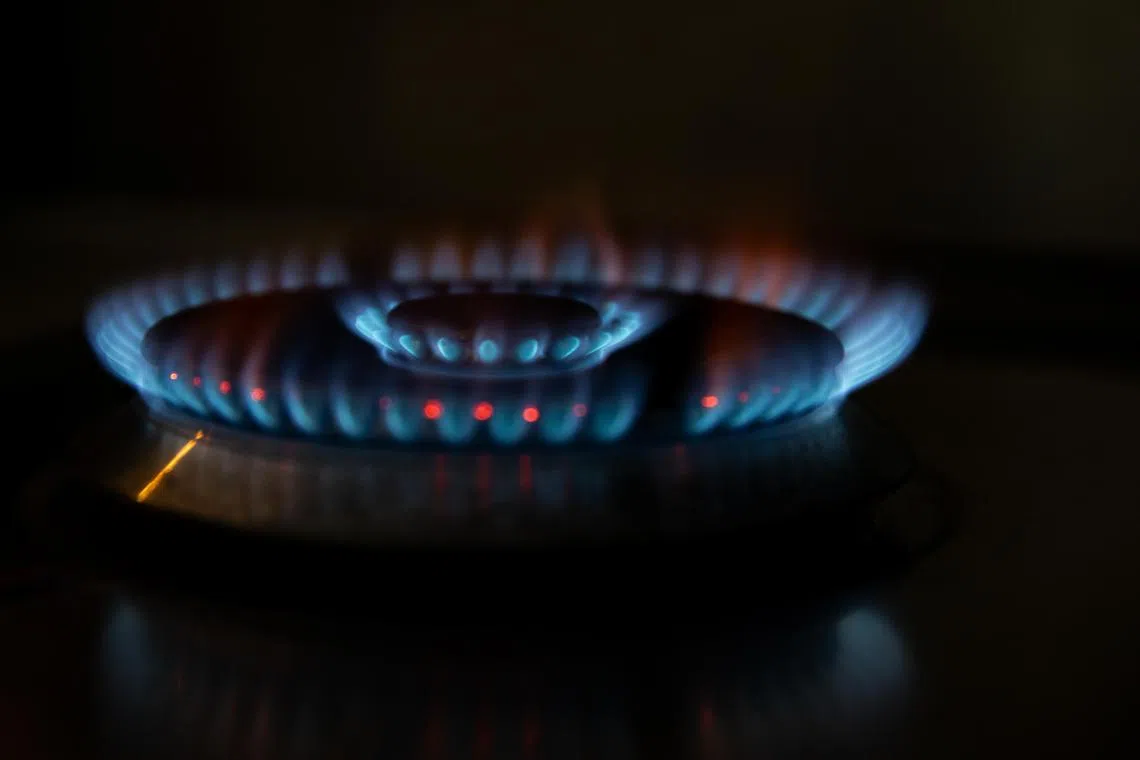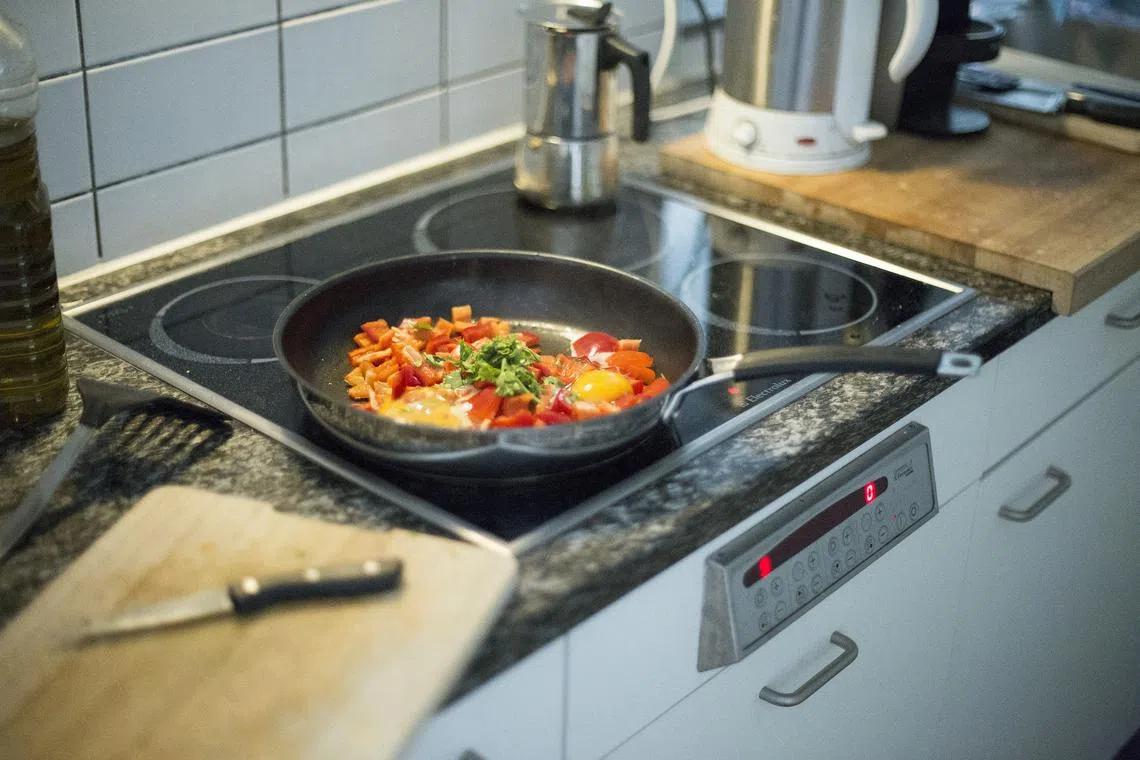Are gas stoves harmful to health and climate?
Sign up now: Get ST's newsletters delivered to your inbox

Gas stoves happen to be one of the major sources of indoor pollution in modern homes because cooking is fuelled by combustible gas.
PHOTO: THE BUSINESS TIMES
Follow topic:
SINGAPORE – When it comes to air pollution, people typically pay more attention to outdoor pollutants and haze, said air quality scientist Rajasekhar Balasubramanian.
“But let’s not forget that we spend a substantial amount of our time indoors. So indoor air quality is probably even more important than outdoor air quality,” said Professor Bala, as he is known. He is from the National University of Singapore’s Department of Civil and Environmental Engineering.
Gas stoves happen to be one of the major sources of indoor pollution in modern homes – especially those with limited ventilation – because cooking is fuelled by combustible gas.
In Singapore, gas stoves fire up mainly from piped town gas and liquefied petroleum gas in canisters. City Energy supplies town gas – comprising methane and hydrogen – that is piped to more than 900,000 homes and businesses.
Prof Bala said: “The gases – like natural gas, methane and propane – contain carbon. And the combustion process is seldom complete. Incomplete combustion could generate carbon monoxide.”
He added: “And another gas being produced along with it is nitrogen dioxide (NO2).” NO2 can be produced during the combustion process in the presence of nitrogen in the air.
Recently, for both health and climate reasons, places such as Oxford in England, Victoria in Australia, and New York have either announced or implemented a ban on gas hobs and connections in new buildings.
Prof Bala said pollution from gas stoves can be a concern in homes with limited ventilation and small kitchens, where pollutants can build up. The release of ultrafine particles from stoves – far smaller than the PM2.5 pollutant from haze – has been a years-long research interest of Prof Bala.
These tiny pollutants from combustion that can be of nano-scale size can cause more lung inflammation and are retained longer in the lung compared to PM2.5. Ultrafine particles can lead to lung cancer in the long run and even travel up to the brain, affecting the nervous system.
The duration and form of cooking also matters. In a 2005 kitchen experiment, Prof Bala found that deep frying and hot oil produced 24 times more ultrafine particles than in a kitchen with no cooking.
The National Environment Agency (NEA) said most households in Singapore already cook in naturally ventilated environments.
Simply Science uncovers the health and climate impacts of using gas stoves in comparison to electric stoves.
Recall movie scenes of residents dying while cocooned at home because the gas stove was accidentally left on? That’s carbon monoxide’s doing.
A recent Stanford University study found that around 50,000 cases of childhood asthma in the US are linked to long-term exposure to nitrogen dioxide from gas and propane stoves.
Dr Ong Kian Chung, president of the Chronic Obstructive Pulmonary Disease Association (Singapore), said fumes from gas stoves can affect anyone depending on the level of pollution, how toxic the irritants are, and each person’s tolerance.
Symptoms such as sneezing, coughing and eye irritation when exposed to fumes from deep frying, for instance, are part of the body’s defence mechanisms and to alert a person to reduce contact with the irritants.
“People who have allergies tend to suffer more from the effects of air pollution because their body constitution is more sensitive,” he added.
Anecdotally, Dr Ong – a respiratory specialist at Chestmed clinic in Mount Elizabeth Medical Centre – has encountered patients with lung disease or asthma who faced worsened symptoms when they cooked more frequently.
The NEA said it is monitoring the scientific literature and international developments on the health impact of gas stoves.
The bottom line is, electric stoves are healthier than gas stoves. But in terms of how green they are is less certain in Singapore.
NEA noted that electric or induction stoves are generally more energy-efficient and less carbon-intensive compared to gas stoves.
A study commissioned in 2023 showed that town gas emits up to 47 per cent less carbon – per kilogram of carbon dioxide (CO2) per kilowatt-hour – compared with electricity, said City Energy. It added that this was due to minimal energy loss during town gas production.
Commenting on the study results, president of the Singapore Green Building Council Lee Ang Seng said: “While town gas on its own does have a lower carbon emissions factor, there is also a need to consider the energy-to-heat conversion efficiency for cooking. Burning methane also releases CO2 into the atmosphere.”
Prof Bala said the ultimate product of burning any fuel containing carbon is planet-warming CO2. Even when gas stoves are not turned on, they leak methane – a more potent greenhouse gas – a Stanford University study had found. According to the 2022 study, methane leaking from stoves in US homes has the same climate impact as about 500,000 petrol-powered cars.
In a move to nudge the phase-out of gas stoves in new buildings, since November 2023, the Building and Construction Authority (BCA) revised its Green Mark 2021 certification scheme to “encourage the widespread adoption of environmentally friendly induction cooktops”.
BCA added: “Any project that fully embraces induction cooktops will receive 0.5 points under the Innovation category of the Resilience section in Green Mark assessments.
“This point-based incentive is applicable to all buildings, including existing buildings undergoing retrofit.”
The minimum criteria a building needs to meet for a Green Mark 2021 certification are at least 50 per cent energy savings based on the 2005 building codes, and 30 points from five sustainability sections.
The authority noted that the incentive will encourage developers and building owners in their transition towards electrification.

NEA noted that electric or induction stoves are generally more energy-efficient and less carbon-intensive compared to gas stoves.
PHOTO: PIXABAY
However, it is still unclear how much more climate-friendly electric stoves are compared to gas stoves in Singapore now – given how about 95 per cent of Singapore’s electricity comes from burning natural gas, the cleanest fossil fuel.
“In both cases, we are combusting gases. But in the case of electric stoves, that burning takes place in a power plant at a distant source. When you have more electric stoves being in operation, the demand for electricity will increase,” said Prof Bala.
Mr Lee said: “Electric stoves can indirectly contribute to carbon emissions through the generation and transmissions of electricity if fossil fuels are used.”
But there are targets to green Singapore’s energy mix and increase the adoption of renewables in the coming years and decades.
“Our buildings must be ready to tap these cleaner sources of energy. As the share of renewables in the electricity grid increases, electric-powered systems in buildings become cleaner and more sustainable. This will be challenging for gas-based systems as they will not be able to take advantage of a cleaner energy grid,” said Mr Lee.
Even with electric stoves, the type of cooking and duration may emit pollutants, noted Prof Bala.
For instance, compared with boiling food on a gas stove, deep frying on an electric stove could emit ultra-fine particles due to the hot oil and type of food in the wok.
“Depending on what you cook and the way you cook... you may find more ultra-fine particles and less nitrogen dioxide with an electric stove,” he added.
For consumers, electric stoves may be costlier than gas hobs. A quick search on home appliance chain Gain City’s website shows gas hobs retailing at $328 to more than $600, and electric stoves retailing at $500 to more than $2,200.
Gas hobs are also more commonly used in Asian cooking, especially to bring about the smoky “wok hei” while stir-frying.
Prof Bala said homes should have an oscillating pedestal fan or a portable air purifier in kitchens to reduce exposure to air pollutants.
NEA said: “It is important to ensure proper ventilation when cooking with gas stoves, such as by using a cooking exhaust hood to dissipate the fumes, or by opening windows. This will help to minimise the build-up of pollutants.”
Simply Science is a new series looking at the science behind everyday questions.
Correction note: In an earlier version of the story, City Energy said a study was commissioned for the Energy Market Authority (EMA). City Energy has since clarified that they conducted the study for presentation to various government agencies, not specifically the EMA.


